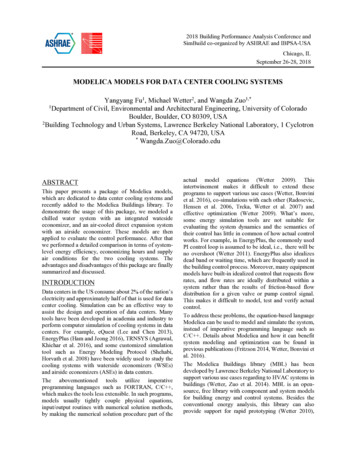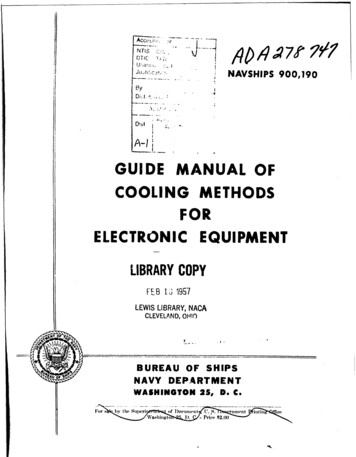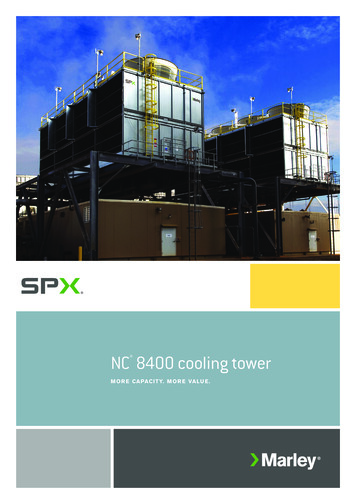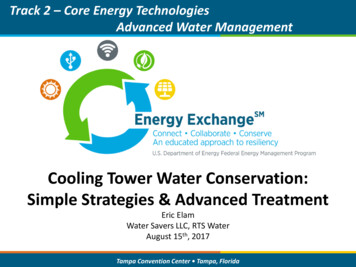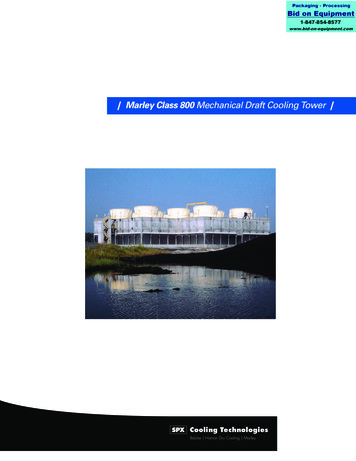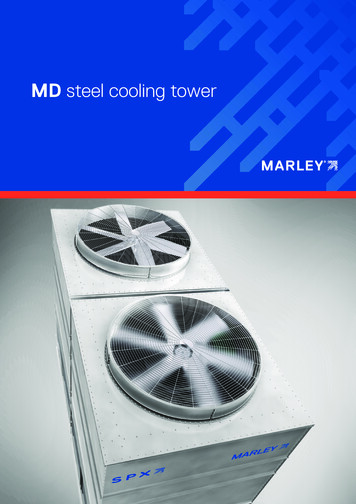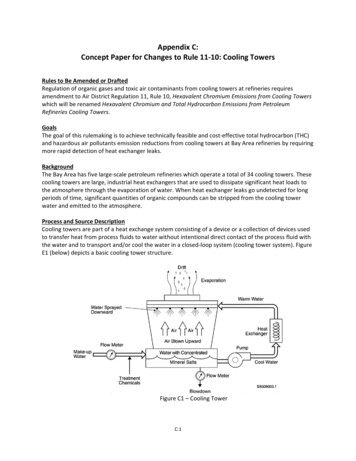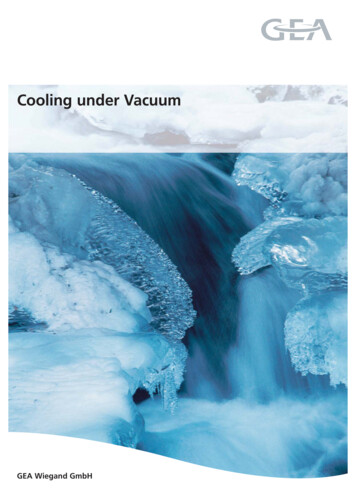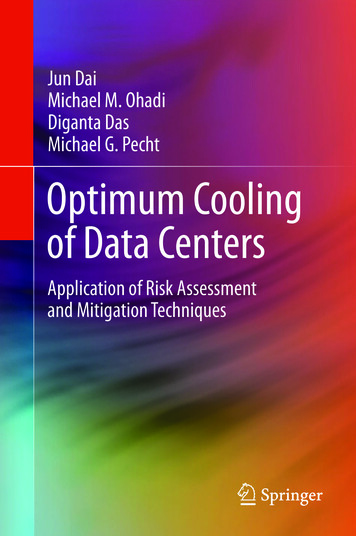
Transcription
Jun DaiMichael M. OhadiDiganta DasMichael G. PechtOptimum Coolingof Data CentersApplication of Risk Assessmentand Mitigation Techniques
Optimum Cooling of Data Centers
Jun Dai · Michael M. Ohadi · Diganta DasMichael G. PechtOptimum Coolingof Data CentersApplication of Risk Assessmentand Mitigation Techniques13
Jun DaiDiganta DasMichael G. PechtCenter Advanced Life Cycle EngineeringUniversity of MarylandCollege ParkMDUSAMichael M. OhadiDepartment of Mechanical EngineeringUniversity of MarylandCollege ParkMDUSAISBN 978-1-4614-5601-8ISBN 978-1-4614-5602-5 (eBook)DOI 10.1007/978-1-4614-5602-5Springer New York Heidelberg Dordrecht LondonLibrary of Congress Control Number: 2013950360 Springer Science Business Media New York 2014This work is subject to copyright. All rights are reserved by the Publisher, whether the whole or partof the material is concerned, specifically the rights of translation, reprinting, reuse of illustrations,recitation, broadcasting, reproduction on microfilms or in any other physical way, and transmission orinformation storage and retrieval, electronic adaptation, computer software, or by similar or dissimilarmethodology now known or hereafter developed. Exempted from this legal reservation are brief excerptsin connection with reviews or scholarly analysis or material supplied specifically for the purpose ofbeing entered and executed on a computer system, for exclusive use by the purchaser of the work.Duplication of this publication or parts thereof is permitted only under the provisions of the CopyrightLaw of the Publisher’s location, in its current version, and permission for use must always be obtainedfrom Springer. Permissions for use may be obtained through RightsLink at the Copyright ClearanceCenter. Violations are liable to prosecution under the respective Copyright Law.The use of general descriptive names, registered names, trademarks, service marks, etc. in this publicationdoes not imply, even in the absence of a specific statement, that such names are exempt from the relevantprotective laws and regulations and therefore free for general use.While the advice and information in this book are believed to be true and accurate at the date ofpublication, neither the authors nor the editors nor the publisher can accept any legal responsibility forany errors or omissions that may be made. The publisher makes no warranty, express or implied, withrespect to the material contained herein.Printed on acid-free paperSpringer is part of Springer Science Business Media (www.springer.com)
PrefaceThe worldwide energy consumption of data centers increased nearly 56 % between2005 and 2010, and reached 237 terawatt hours (TWh) in 2010, accounting forabout 1.3 % of the world’s electricity usage [1]. In the US, data center energy consumption increased by about 36 % between 2005 and 2010, reaching 76 TWh andaccounting for about 2 % of total US electricity consumption in 2010 [1]. Coolingsystems (primarily air conditioners) in data centers account for a large part of thisenergy consumption: in 2009, about 40 % of the energy consumed by data centerswas for cooling [2, 3].A 2012 biannual survey by Emerson Network Power polled members of theData Center Users’ Group, an association of data center, IT, and facility managers,about the greatest issues facing data centers. Energy efficiency was cited as the primary concern, followed by availability and infrastructure monitoring. The electricity cost to remove the heat generated from the server racks has continued to rise tothe point that the 4-year energy costs of operating many data centers exceeds theirpurchase price.Realizing nearly 40 % of the power supplied to a typical data center is spent oncooling infrastructure; numerous approaches are underway to realize substantialreductions in energy consumption of data centers. One such example is ‘‘free aircooling,’’ where ambient air under proper temperature and humidity conditions isbrought into the data center to cool the equipment directly, thereby reducing theenergy consumed in cooling and conditioning. Numerous successful examplesof free air cooling have demonstrated substantial energy savings, and some haveachieved a power usage effectiveness (PUE) of nearly 1. However, a systematicexamination of the impact of free air cooling on the performance and reliabilityof telecommunication equipment is needed. The implementation of free air cooling changes the operating environment, such as the temperature and humidity, andmay have a significant impact on performance and reliability.Maintaining the high availability of data centers requires reliability methodsthat provide useful information about impending failures, identify failure locations, and help isolate failure causes, while taking into account the life cycleconditions during system service. Traditional standards-based standard qualification methods will not work when free air cooling is implemented in data centersalready in operation, since it is usually not practical to interrupt equipment servicefor re-qualification purposes.v
viPrefaceThe purpose of this book is to provide data center designers and operators withmethods by which to assess and mitigate the risks associated with utilization ofoptimum cooling solutions. The goal is to provide readers with sufficient knowledge to implement new/emerging measures such as free air cooling and direct liquid immersion cooling properly in data centers, base stations, and server farms,and addresses the following questions: What are the cost/benefits associated with an optimum cooling solution for thegiven system? How could the given optimum cooling method(s) be implemented in the givendata center? Are the current telecom industry standards sufficient/applicable for the selectedoptimum cooling method(s)? What are the potential risks and failure mechanisms associated with the implementation of the optimum cooling method(s)? How can the risks to the performance and reliability of telecom equipmentunder optimum cooling conditions be assessed? How can the associated risks to telecom equipment at multiple life cycle stages(design, test, and operation) be mitigated? Why is prognostics and health management (PHM) a proper risk mitigationmethod for the operation stage?This book discusses various telecommunication infrastructures, with an emphasis on data centers and base stations. Among the various energy and power management techniques, this book covers the most commonly known, as well as emergingcooling solutions for data centers. The risks to the electronic equipment fitted inthese installations and the methods of risk mitigation are described. The bookdevotes a particular focus to an up-to-date review of the emerging cooling methods(such as free air cooling and direct liquid immersion cooling), tools and best practices for installation operators, informs installation designers and manufacturers ofthe benefits and limitations of most common existing and emerging cooling methods, and prepares the designers and manufacturers of electronics for these installations to develop and supply products that meet the operators’ availability, reliability,and performance requirements under the optimum cooling regime.Chapter 1 provides an overview of the global telecom industry based on thecurrent market and predicted future trends. The reasons for reducing energy consumption are also discussed in detail, including energy costs, environmental concerns, and government regulations.Chapter 2 provides an overview of the main components (power equipment,cooling equipment, and IT equipment) and operating environments in data centers,as well as the energy efficiency metrics by which they are measured. It also introduces the methods for improving energy efficiency in telecom devices and in datacenters, which include more efficient technologies for telecom devices, reducingthe required computational power by improving application management, improving the efficiency of servers, improving the efficiency of power supplies and distribution, and improving the efficiency of cooling equipment.
PrefaceviiChapter 3 introduces the standards for telecom equipment and data centers,including the qualification environmental standards for telecom equipment and thestandards providing data center thermal guidelines and design, installation, andperformance requirements. These standards include TL 9000, which can be usedto evaluate the quality of telecom equipment and assess the impact of free air cooling on telecom equipment; TIA-942, which focuses on the design and installationof data centers; and ASHRAE thermal guidelines. The application of these standards under free air cooling conditions is also discussed.Chapter 4 introduces the principal cooling methods most commonly used, aswell as emerging optimum cooling solutions that seek to minimize energy consumption requirements without compromising the integrity of the data and thequality of service by the particular data center. Measures such as air conditioning/cooling with improved power management technologies, liquid cooling, free aircooling, tower free cooling, and comparison of the cooling methods are covered.When applicable the methods considered are compared in terms of energy efficiency, retrofit cost, and weather dependence. This chapter also plays a particular focus on free air cooling, its operation principals, opportunities, and challengesassociated with use of free air cooling. Several data center design case studyscenarios of free air cooling are also discussed, along with their potential energysavings, as well as other considerations and findings based on the available data.Chapter 5 presents the potential risks to telecom equipment under free coolingconditions due to changes in the operating environment, including temperature,humidity, and contamination, as an example of risk analysis for the optimum cooling methods. Various relevant risk assessment procedures and the associated standards are reviewed in this chapter. The most critical unknown factor that remains inthe assessment of reliability is the actual conditions under free air cooling, sincethere is not enough publicly available data to determine the actual environmental envelope under free air cooling. In addition, the most significant differencebetween free air cooling and traditional air conditioning is the diversity amongvarious free air cooled data centers, which vary in terms of their location, the specific architecture of the free air cooling, and the inclusion of other power management methods in conjunction with free air cooling.Chapter 6 presents steps to identify the parts of the telecom equipment withthe highest potential risks under optimum cooling conditions and provides a process for assessing whether, if appropriate optimums to the parts are available, theoptimums are qualified under the new environment. If the appropriate optimumsare not practical or possible, uprating methods are introduced to assess whetherthe original parts are qualified under optimum cooling conditions. Three upratingmethods (parameter re-characterization, parameter conformance, and stress balancing) are presented with examples to show the steps for their implementation.The uprating methods are compared, and methods for selecting an appropriateuprating method are introduced in this chapter.Chapter 7 presents guidelines for assessing part reliability under optimumcooling conditions. Handbook-based reliability predictions have been used fordecades; however, they do not consider the failure mechanisms and provide only
viiiPrefacelimited insight into practical reliability issues. As a result, they cannot offer accurate predictions. This chapter presents several methods to replace the handbookmethods at different product lifecycle stages. At the design and test stages, themanufacturers can use physics-of-failure (PoF) and accelerated testing to predictpart reliability. At the operation stage, when the products are being used in thefield, the field data can be analyzed to estimate reliability.When optimum cooling is implemented in data centers already in operation,traditional reliability assessment methods and current standards-based qualification methods are insufficient to estimate the reliability of telecom equipment.Thus, Chap. 8 introduces prognostics and health management (PHM), which canbe applied to identify and mitigate the system-level risks of operating telecomequipment under free air cooling conditions. This chapter provides a basic introduction to PHM, the monitoring techniques for PHM, and PHM approaches. Thephysics-of-failure approach, the data-driven approach, and a combination of bothapproaches (fusion approach) are introduced. Chapter 8 also presents a multi-stagemethod to identify and mitigate the potential risks to telecommunication equipment under energy conservation measures such as free air cooling conditions, thusproviding a case example of how the PHM approaches can be used to mitigaterisks associated with use of optimum cooling method.Chapter 9 presents some common features of next-generation data centers.Emerging trends of next-generation data centers suggest that they will be moreenergy efficient, use space more efficiently, use higher-density electronic components, reduce capital and operational costs, use optimized cooling methods, reduceemissions to net-zero, increasingly use hardware and software in the integrateddesign and operation/management of the center, increasingly use cloud computing,and make continuous progress in use of risk assessment and mitigation techniquesto take advantage of optimum infrastructure design/installation and operationmeasures.This book offers information for sustainable design and operating principlesthat meet expectations of next-generation data centers. The focus of the book ison optimum cooling and other energy recovery and efficiency improvement measures; thus, it will be useful for stakeholders in both the IT and HVAC industries,including facility developers/designers, HVAC equipment manufacturers, IT andtelecom equipment manufacturers, and data center end-users/owners, operators,and energy auditors. The book will be valuable for researchers and academic communities as well in their search for future solutions and further enhancements inthis growing and promising field. What distinguishes this book from previousbooks in the field is the analysis that it offers a review of the potential risks due tothe implementation of optimum cooling methods (free air cooling, as an example)and a set of assessment methods for part performance and reliability. Additionally,for data center and base station designers, this book provides a review of theguidelines and regulations imposed, the goals set by governments, and a review ofall variations of optimum cooling techniques. For data center operators, this bookprovides a prognostics-based assessment to identify and mitigate the risks of telecom equipment under optimum cooling conditions.
PrefaceixThe authors wish to thank Dr. Bo Song who led writing Chap. 5. Her effortsare much appreciated. We also thank Dr. Serguei Dessiatoun and Dr. KyosungChoo of the Smart and Small Thermal Systems Laboratory at the Universityof Maryland for their contributions to Chaps. 2 and 9. We are grateful to Profs.Avram Bar-Cohen of the University of Maryland and Yogendra Joshi of GeorgiaTech for their discussions on contemporary issues and future trends in thermalpackaging of electronics. References1. J.G. Koomey, Growth in data center electricity use 2005 to 2010 (AnalyticsPress, Oakland, 2011)2. A. Almoli, A. Thompson, N. Kapur, J. Summers, H. Thompson, G. Hannah,Computational fluid dynamic investigation of liquid rack cooling in data centres, Appl. Energy. 89(1), 150–155 (2012)3. P. Johnson, T. Marker, Data center energy efficiency product profile, Pitt & Sherry,Report to equipment energy efficiency committee (E3) of The AustralianGovernment Department of the Environment, Water, Heritage and the Arts(DEWHA), Apr. (2009)
Contents1 The Telecom Industry and Data Centers . . . . . . . . . . . . . . . . . . . . . . . .1.1 An Overview of the Telecom Industry Market. . . . . . . . . . . . . . . . . .1.1.1 The Global Telecom Market. . . . . . . . . . . . . . . . . . . . . . . . . .1.1.2 The United States Telecom Market . . . . . . . . . . . . . . . . . . . .1.2 Energy Consumption. . . . . . . . . . . . . . . . . . . . . . . . . . . . . . . . . . . . .1.2.1 The Cost of Energy. . . . . . . . . . . . . . . . . . . . . . . . . . . . . . . . .1.2.2 Environmental Issues. . . . . . . . . . . . . . . . . . . . . . . . . . . . . . .1.2.3 Government Regulations . . . . . . . . . . . . . . . . . . . . . . . . . . . .1.3 Summary . . . . . . . . . . . . . . . . . . . . . . . . . . . . . . . . . . . . . . . . . . . . . .References. . . . . . . . . . . . . . . . . . . . . . . . . . . . . . . . . . . . . . . . . . . . . . . . . .11123446882 Data Center Energy Flow and Efficiency. . . . . . . . . . . . . . . . . . . . . . . .2.1 Data Centers. . . . . . . . . . . . . . . . . . . . . . . . . . . . . . . . . . . . . . . . . . . .2.1.1 Power Equipment. . . . . . . . . . . . . . . . . . . . . . . . . . . . . . . . . .2.1.2 Cooling Equipment . . . . . . . . . . . . . . . . . . . . . . . . . . . . . . . .2.1.3 IT Equipment. . . . . . . . . . . . . . . . . . . . . . . . . . . . . . . . . . . . .2.2 Energy Efficiency Metrics. . . . . . . . . . . . . . . . . . . . . . . . . . . . . . . . .2.3 Methods to Improve Energy Efficiency. . . . . . . . . . . . . . . . . . . . . . .2.3.1 Efficient Electronics. . . . . . . . . . . . . . . . . . . . . . . . . . . . . . . .2.3.2 Efficient Software Applications. . . . . . . . . . . . . . . . . . . . . . .2.3.3 Efficient Power Supply and Distributions . . . . . . . . . . . . . . .2.3.4 Efficient Cooling Systems. . . . . . . . . . . . . . . . . . . . . . . . . . .2.4 Case Study Example on Data Center EnergySaving Opportunities. . . . . . . . . . . . . . . . . . . . . . . . . . . . . . . . . . . . .2.4.1 Analysis of Energy Consumption. . . . . . . . . . . . . . . . . . . . . .2.4.2 Energy Consumption Simulations. . . . . . . . . . . . . . . . . . . . .2.4.3 Energy Conservation Findings. . . . . . . . . . . . . . . . . . . . . . . .2.5 Summary . . . . . . . . . . . . . . . . . . . . . . . . . . . . . . . . . . . . . . . . . . . . . .References. . . . . . . . . . . . . . . . . . . . . . . . . . . . . . . . . . . . . . . . . . . . . . . . . .991111121315151616171717222629293 Standards Relating to Data Center. . . . . . . . . . . . . . . . . . . . . . . . . . . . .3.1 ASHRAE Thermal Guidelines. . . . . . . . . . . . . . . . . . . . . . . . . . . . . .3.2 TIA-942 Data Center Standard. . . . . . . . . . . . . . . . . . . . . . . . . . . . . .313134xi
Contentsxii3.3Environmental Qualification Standards. . . . . . . . . . . . . . . . . . . . . . .3.3.1 Telcordia GR-63-CORE. . . . . . . . . . . . . . . . . . . . . . . . . . . . .3.3.2 ETSI 300 019. . . . . . . . . . . . . . . . . . . . . . . . . . . . . . . . . . . . .3.3.3 Use for Data Center Cooling Methods. . . . . . . . . . . . . . . . . .3.4 Quality Management Standard: TL 9000. . . . . . . . . . . . . . . . . . . . . .3.4.1 Metrics in TL 9000. . . . . . . . . . . . . . . . . . . . . . . . . . . . . . . . .3.4.2 Use for Data Centers . . . . . . . . . . . . . . . . . . . . . . . . . . . . . . .3.5 Summary . . . . . . . . . . . . . . . . . . . . . . . . . . . . . . . . . . . . . . . . . . . . . .References. . . . . . . . . . . . . . . . . . . . . . . . . . . . . . . . . . . . . . . . . . . . . . . . . .3636384141424445454 Principal Cooling Methods. . . . . . . . . . . . . . . . . . . . . . . . . . . . . . . . . . . .4.1 Principal Cooling Methods. . . . . . . . . . . . . . . . . . . . . . . . . . . . . . . . .4.1.1 Air Cooling. . . . . . . . . . . . . . . . . . . . . . . . . . . . . . . . . . . . . . .4.1.2 Liquid Cooling. . . . . . . . . . . . . . . . . . . . . . . . . . . . . . . . . . . .4.1.3 Liquid Immersion Cooling. . . . . . . . . . . . . . . . . . . . . . . . . . .4.1.4 Tower Free Cooling. . . . . . . . . . . . . . . . . . . . . . . . . . . . . . . .4.1.5 Enhanced Cooling Utilizing PowerManagement Technologies. . . . . . . . . . . . . . . . . . . . . . . . . . .4.1.6 Comparison of Principal Cooling Methods. . . . . . . . . . . . . .4.2 Free Air Cooling. . . . . . . . . . . . . . . . . . . . . . . . . . . . . . . . . . . . . . . . .4.2.1 Operation of Airside Economizer. . . . . . . . . . . . . . . . . . . . . .4.2.2 Operating Environment Setting. . . . . . . . . . . . . . . . . . . . . . .4.2.3 Energy Savings from Free Air Cooling . . . . . . . . . . . . . . . . .4.2.4 Hidden Costs of Free Air Cooling. . . . . . . . . . . . . . . . . . . . .4.2.5 Examples of Free Air Cooling. . . . . . . . . . . . . . . . . . . . . . . .4.3 Summary . . . . . . . . . . . . . . . . . . . . . . . . . . . . . . . . . . . . . . . . . . . . . .References. . . . . . . . . . . . . . . . . . . . . . . . . . . . . . . . . . . . . . . . . . . . . . . . . .474747495053535455565759646567685 Reliability Risks Under Free Air Cooling. . . . . . . . . . . . . . . . . . . . . . . .5.1 Failure Causes Under Free Air Cooling. . . . . . . . . . . . . . . . . . . . . . .5.1.1 Increased Temperature and Temperature Variation . . . . . . . .5.1.2 Uncontrolled Humidity . . . . . . . . . . . . . . . . . . . . . . . . . . . . .5.1.3 Contamination . . . . . . . . . . . . . . . . . . . . . . . . . . . . . . . . . . . .5.2 Failure Mechanisms Under Free Air Cooling . . . . . . . . . . . . . . . . . .5.2.1 Electrostatic Discharge. . . . . . . . . . . . . . . . . . . . . . . . . . . . . .5.2.2 Conductive Anodic Filament Formation . . . . . . . . . . . . . . . .5.2.3 Electrochemical Migration. . . . . . . . . . . . . . . . . . . . . . . . . . .5.2.4 Corrosion . . . . . . . . . . . . . . . . . . . . . . . . . . . . . . . . . . . . . . . .5.3 Testing for Free Air Cooling . . . . . . . . . . . . . . . . . . . . . . . . . . . . . . .5.3.1 Mixed Flowing Gas (MFG) Test . . . . . . . . . . . . . . . . . . . . . .5.3.2 Dust Exposure Tests. . . . . . . . . . . . . . . . . . . . . . . . . . . . . . . .5.3.3 Clay Test. . . . . . . . . . . . . . . . . . . . . . . . . . . . . . . . . . . . . . . . .5.3.4 Temperature/Humidity/Bias (THB) Testing. . . . . . . . . . . . . .5.3.5 Salt Spray Testing. . . . . . . . . . . . . . . . . . . . . . . . . . . . . . . . . .5.3.6 Cyclic Temperature/Humidity Testing. . . . . . . . . . . . . . . . . .7171717374767676787983838586888889
Contentsxiii5.3.7 Water Spray Testing. . . . . . . . . . . . . . . . . . . . . . . . . . . . . . . .5.4 Summary . . . . . . . . . . . . . . . . . . . . . . . . . . . . . . . . . . . . . . . . . . . . . .References. . . . . . . . . . . . . . . . . . . . . . . . . . . . . . . . . . . . . . . . . . . . . . . . . .9090916 Part Risk Assessment and Mitigation. . . . . . . . . . . . . . . . . . . . . . . . . . .6.1 Part Datasheet. . . . . . . . . . . . . . . . . . . . . . . . . . . . . . . . . . . . . . . . . . .6.1.1 Datasheet Contents. . . . . . . . . . . . . . . . . . . . . . . . . . . . . . . . .6.1.2 Understanding the Part Number. . . . . . . . . . . . . . . . . . . . . . .6.1.3 Ratings of an Electronic Part. . . . . . . . . . . . . . . . . . . . . . . . .6.1.4 Thermal Characteristics. . . . . . . . . . . . . . . . . . . . . . . . . . . . .6.1.5 Electrical Specifications. . . . . . . . . . . . . . . . . . . . . . . . . . . . .6.2 Part Uprating . . . . . . . . . . . . . . . . . . . . . . . . . . . . . . . . . . . . . . . . . . .6.2.1 Steps of Part Uprating . . . . . . . . . . . . . . . . . . . . . . . . . . . . . .6.2.2 Parameter Conformance. . . . . . . . . . . . . . . . . . . . . . . . . . . . .6.2.3 Parameter Re-characterization. . . . . . . . . . . . . . . . . . . . . . . .6.2.4 Stress Balancing. . . . . . . . . . . . . . . . . . . . . . . . . . . . . . . . . . .6.2.5 Continuing Steps After Uprating. . . . . . . . . . . . . . . . . . . . . .6.3 Summary . . . . . . . . . . . . . . . . . . . . . . . . . . . . . . . . . . . . . . . . . . . . . .References. . . . . . . . . . . . . . . . . . . . . . . . . . . . . . . . . . . . . . . . . . . . . . . . . .9595959697991011021021041071111121131137 Part Reliability Assessment in Data Centers . . . . . . . . . . . . . . . . . . . . .7.1 Part Capability. . . . . . . . . . . . . . . . . . . . . . . . . . . . . . . . . . . . . . . . . .7.2 Example Handbook-Based Reliability Prediction Methods. . . . . . . .7.2.1 Mil-hdbk-217. . . . . . . . . . . . . . . . . . . . . . . . . . . . . . . . . . . . .7.2.2 Telcordia SR-332. . . . . . . . . . . . . . . . . . . . . . . . . . . . . . . . . .7.2.3 How the Handbook Calculations Work . . . . . . . . . . . . . . . . .7.2.4 How the Operating Environments are Handled. . . . . . . . . . .7.2.5 Insufficiency of the Handbook Methods . . . . . . . . . . . . . . . .7.3 Prognostics and Health Management Approaches. . . . . . . . . . . . . . .7.3.1 Monitoring Techniques for PHM. . . . . . . . . . . . . . . . . . . . . .7.3.2 Physics-of-Failure Approach. . . . . . . . . . . . . . . . . . . . . . . . .7.3.3 Data-Driven Approach. . . . . . . . . . . . . . . . . . . . . . . . . . . . . .7.3.4 Fusion Approach . . . . . . . . . . . . . . . . . . . . . . . . . . . . . . . . . .7.3.5 Use for the Efficient Cooling Methods. . . . . . . . . . . . . . . . . .7.4 Other Approaches. . . . . . . . . . . . . . . . . . . . . . . . . . . . . . . . . . . . . . . .7.5 Summary . . . . . . . . . . . . . . . . . . . . . . . . . . . . . . . . . . . . . . . . . . . . . .References. . . . . . . . . . . . . . . . . . . . . . . . . . . . . . . . . . . . . . . . . . . . . . . . . 378 Life Cycle Risk Mitigations . . . . . . . . . . . . . . . . . . . . . . . . . . . . . . . . . . .8.1 Risk Assessment Based on Product Life Cycle Stage. . . . . . . . . . . .8.2 Risk Assessment at the Design Stage. . . . . . . . . . . . . . . . . . . . . . . . .8.2.1 Initial Design . . . . . . . . . . . . . . . . . . . . . . . . . . . . . . . . . . . . .8.2.2 Part Selection. . . . . . . . . . . . . . . . . . . . . . . . . . . . . . . . . . . . .8.2.3 Virtual Qualification. . . . . . . . . . . . . . . . . . . . . . . . . . . . . . . .8.2.4 Simulation and Final Design . . . . . . . . . . . . . . . . . . . . . . . . .141141142143143144145
Contentsxiv8.3Risk Assessment at the Test Stage. . . . . . . . . . . . . . . . . . . . . . . . . . .8.3.1 Standards-Based Assessment. . . . . . . . . . . . . . . . . . . . . . . . .8.3.2 Uprating Assessment . . . . . . . . . . . . . . . . . . . . . . . . . . . . . . .8.4 Risk Assessment at the Operation Stage . . . . . . . . . . . . . . . . . . . . . .8.5 A Case Study of Network Equipment . . . . . . . . . . . . . . . . . . . . . . . .8.5.1 Estimation of Operating Conditions. . . . . . . . . . . . . . . . . . . .8.5.2 FMMEA and Identification of Weak Subsystems . . . . . . . . .8.5.3 System and Weak Subsystem Monitoring. . . . . . . . . . . . . . .8.5.4 Anomaly Detection. . . . . . . . . . . . . . . . . . . . . . . . . . . . . . . . .8.5.5 Prognostics. . . . . . . . . . . . . . . . . . . . . . . . . . . . . . . . . . . . . . .8.6 Summary . . . . . . . . . . . . . . . . . . . . . . . . . . . . . . . . . . . . . . . . . . . . . .References. . . . . . . . . . . . . . . . . . . . . . . . . . . . . . . . . . . . . . . . . . . . . . . . . .1461461471481491501511511521551561569 Emerging Trends. . . . . . . . . . . . . . . . . . . . . . . . . . . . . . . . . . . . . . . . . . . .9.1 Increased Use of Software Tools for Optimumand Reliable Operation. . . . . . . . . . . . . . . . . . . . . . . . . . . . . . . . . . . .9.2 Trends in Development of Energy Efficient Electronics. . . . . . . . . .9.3 Embedded (Near Source) Cooling. . . . . . . . . . . . . . . . . . . . . . . . . . .9.3.1 Enhanced Air Cooling . . . . . . . . . . . . . . . . . . . . . . . . . . . . . .9.3.2 CRAC Fan Speed Control . . . . . . . . . . . . . . . . . . . . . . . . . . .9.3.3 Direct Liquid Cooling . . . . . . . . . . . . . . . . . . . . . . . . . . . . . .9.3.4 Direct Phase-Change Cooling . . . . . . . . . . . . . . . . . . . . . . . .9.3.5 Comparison Between Embedded Air, Liquid,and Two-Phase Flow Cooling. . . . . . . . . . . . . . . . . . . . . . . . .9.4 Net-Zero Emission Data Centers. . . . . . . . . . . . . . . . . . . . . . . . . . . .9.5 Mission Critical Data Centers . . . . . . . . . . . . . . . . . . . . . . . . . . . . . .9.6 Waste Heat Recovery/Chiller-less Cooling . . . . . . . . . . . . . . . . . . . .9.7 Summary . . . . . . . . . . . . . . . . . . . . . . . . . . . . . . . . . . . . . . . . . . . . . .References. . . . . . . . . . . . . . . . . . . . . . . . . . . . . . . . . . . . . . . . . . . . . . . . . y. . . . . . . . . . . . . . . . . . . . . . . . . . . . . . . . . . . . . . . . . . . . . . . . . . . . . . 175
Chapter 1The Telecom Industry and Data CentersThe telecommunications industry encompasses the information and communicationtechnology (ICT) sectors, ranging from fixed telephone, broadband Internet, andmobile wireless applications to cable television. The supporting backbone of the telecom industry’s infrastructure is data centers, which comprise the buildings, facilities, and rooms that contain enterprise servers and equipment for communications,cooling, and power distribution and control. This chapter overviews the telecomindustry market and the need for energy consumption reduction/optimization in datacenters.1.1 An Overview of the Telecom Industry MarketThe telecommunications industry is essential to the global economy and plays akey role in almost every sector of society. Insight Research estimated that globaltelecom spending as
systems (primarily air conditioners) in data centers account for a large part of this energy consumption: in 2009, about 40 % of the energy consumed by data centers was for cooling [2, 3]. A 2012 biannual survey by Emerson Network Power polled members of the Data Center Users' Group, an association of data center, IT, and facility managers,

